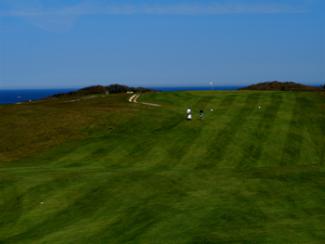Featured Golf News
Highland Links - Over a Century Old & Still a Treat
The fairways are rock-hard, which means tee shots will roll forever. The wind howls and swirls and creates havoc with club selection. The greens are only slightly larger than the amount of cash in my wallet after filling my gas tank. Trees? There aren't any. But there's heather, fescue, wildflowers, shrubby pine and bunkers deep as craters. There are also stunning views from windswept bluffs overlooking the Atlantic Ocean.

A Green at Highland Links Overlooking the Atlantic
(photo by Ron Hyams)
It's a place that Alistair Cooke once called "the perfect example of British or Scottish links in the United States." That's the beauty of Highland Links in North Truro, Mass. - the closest you will come on Cape Cod to a genuine links course without actually jetting across the pond.
Built in 1892, Highland is the Cape's oldest course - and looks every bit its age. And that's by design. There aren't any frills here. No fancy clubhouse or oak-lined grille room; just a basic snack bar. No elaborate practice facility; just a small putting green. And it's only nine holes, a par-35 measured out at barely more than 2,500 yards. But if you love golf history, you'll quickly understand that simplicity is the point.
Imagine playing a course once enjoyed by the legendary Francis Ouimet. The winner of the historic 1913 U.S. Open played an exhibition round at Highland before the greens were converted from sand to grass. The original course stood next to an ocean-side hotel and cottage resort. Both are long gone, replaced by the Truro Historical Museum.

You Want to Find the Fairways at Highland Links
(photo by Ron Hyams)
First laid out by Willard Small, it was redesigned in 1913 by J. Henry McKinley, a New Yorker who often stayed in the hotel. Another redesign took place in 1955, and when Congress approved President Kennedy's Cape Cod National Seashore Act in 1961, Highland Links became federal property leased to the town of Truro.
Highland Links will force you to play a different brand of golf, where knock-down shots, bump-and-runs and delicate chips are the desired option. The greens aren't especially fast, but they're undulating and a challenge to read. The par-5s are reachable in two (long hitters can drive a few par-4s), but there are risks involved in taking that route.
Along the way you will play shots toward historic Cape Cod Light, which guards the green at the par-3 seventh hole. You'll walk along fairways that parallel the Atlantic, staring from a cliff to the water below. Even though you might stumble a bit with a bogey or two, you will find it difficult to become disenchanted while strolling across such a unique course.

The Lighthouse on Display at Highland Links
(photo by Ron Hyams)
The fun begins on the 250-yard, downhill opener. From an elevated tee, you can scan the surroundings all the way to the water and spot the FAA flight-service domes in the distance, while deciding if it's worth the gamble to attempt driving the green. A solid tee shot can reach the putting surface, but a slightly off-line ball could find deep fescue or one of the two bunkers flanking the green. The wiser play is a 3- or 5-wood, leaving only a wedge for the approach.
There are more decisions and beauty on the par-5 second. From another heightened tee, with a medieval granite tower standing guard from above the fairway - a memorial to 19th century singer Jenny Lind, you must fit your tee shot into a deep valley. Miss either side and you'll be dropping a new ball. The 460-yard hole is reachable in two, but you must be precise. Bunkers guard the front of the green and shots that run long will roll into thick fescue.
The third hole defines Highland Links. A par-3 of only 160 yards, the green is perched atop a hill, making it a blind shot. The prevailing wind is in your face, and with the Atlantic only steps away, it's usually fierce. Balls that land short will catch the hill and roll to the bottom, leaving a long, treacherous chip uphill to a pin you won't be able to see.
Without doubt, the most memorable hole is the 464-yard sixth, which runs alongside a cliff that drops 130 feet to the ocean. Coastal erosion threatens its continued existence. Though not an especially difficult par-5, unless the wind is howling in your face, it's a visually stunning walk to the green.
Cape Cod Light serves as the backdrop for the 170-yard seventh, and the course closes with the spectacular ninth, with its tee box mere feet from the rear door of the Truro Historical Museum. Only 136 yards, this hole has been ranked by national magazines as one of the world's greatest par-3s. The two-tiered green, which is severely sloped from right to left, means that hitting the green from the tee guarantees nothing it all.
Thus ends your journey at Highland Links. Of course, you can go around a second time to complete a regulation 18-hole round. In fact, you'd be crazy not to.
For more information, visit http://highlandlinkscapecod.com.
Rob Duca is an award-winning sports columnist who wrote for the Cape Cod Times for 25 years, covering golf, the Boston Red Sox, the Boston Celtics and the Boston Bruins. He is now managing editor of Golf & Leisure Cape Cod magazine and has written for a variety of other publications, including Sports Illustrated, the Boston Globe, Yankee magazine and Cape Cod Life.
Story Options
 |
Print this Story |
